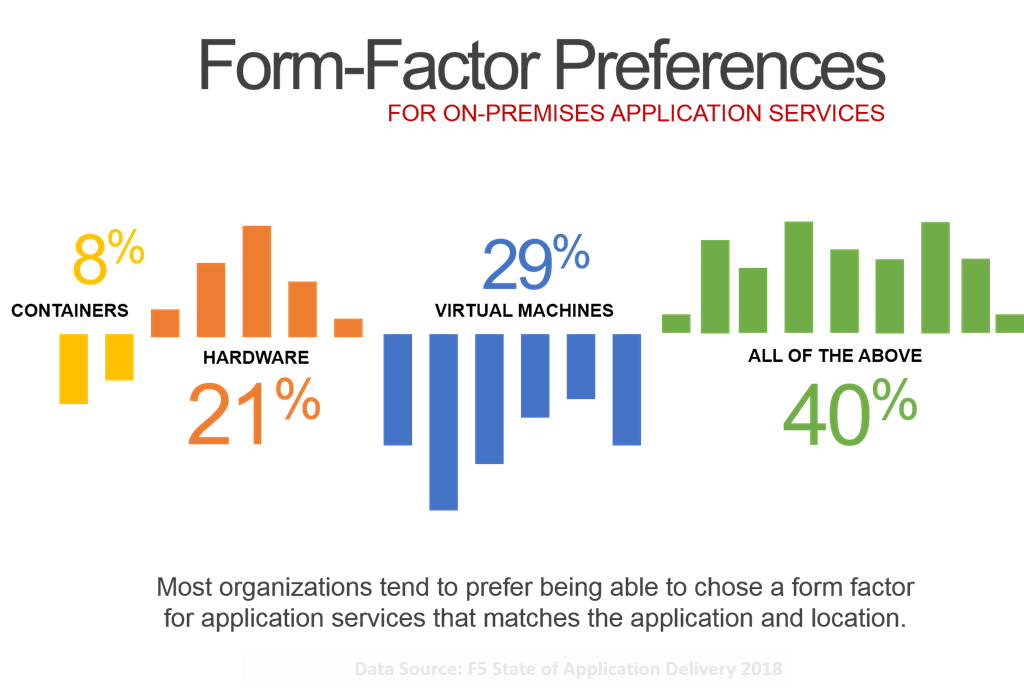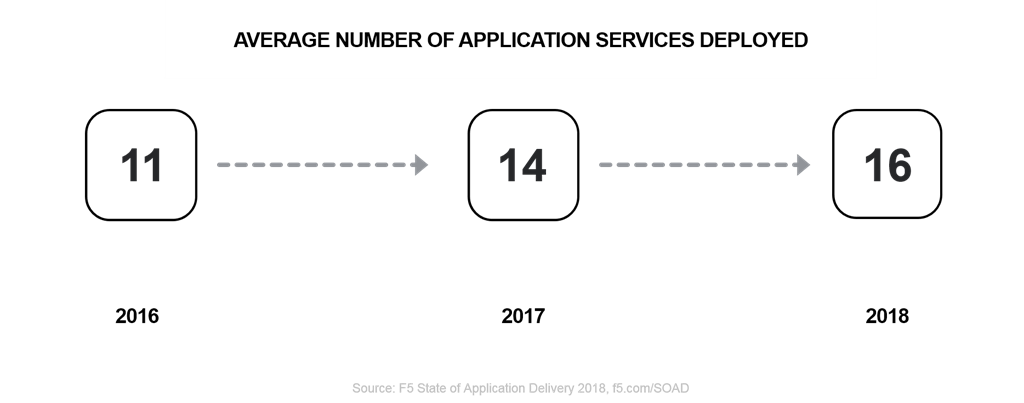Wie Cloud und Container die Disaggregation von Anwendungsdiensten vorantreiben

- Anwendungen beeinflussen Entscheidungen zu allen Aspekten, vom Standort bis zum Formfaktor der unterstützenden Bereitstellungsinfrastruktur. 55 % der Organisationen wählen eine Cloud auf Grundlage der Anwendungsbedürfnisse und -anforderungen aus. 40 % möchten den richtigen Formfaktor für die App auswählen können. (Stand der Anwendungsbereitstellung 2018)
- Da Cloud- und Microservices-Architekturen Apps aufteilen und verteilen, wird die gemeinsam genutzte Infrastruktur zu einer Belastung statt zu einem Vorteil und treibt die Kapital- und Betriebskosten in die Höhe.
- Kosten, Konfiguration und Upgrades sind die Hauptfaktoren für die Unterstützung von Pro-App-Architekturen mit Pro-App-Anwendungsdiensten.
- Zur Unterstützung moderner Apps und Architekturen ist ein Pro-App-Ansatz für Anwendungsdienste erforderlich.
In den letzten Jahren haben Cloud-Anbieter wie Amazon, Microsoft, Google und andere große Anstrengungen unternommen, um den Bedarf der Unternehmen an Anwendungsdiensten zu decken.

Heutzutage finden Sie auf Cloud-Marktplätzen eine Reihe (und es werden immer mehr) von Anwendungsdiensten, die sich sowohl mit Sicherheit (wie Web Application Firewalls) als auch mit Leistung (Caching) und sogar Identitätsmanagement befassen. Das ist keine Überraschung. Unternehmen sind im Durchschnitt auf 16 verschiedene Anwendungsdienste angewiesen, um ihre Apps schneller und sicherer zu machen. Diese Zahl wird jedes Jahr größer. Unternehmen werden sie nicht der Geschwindigkeit der Cloud opfern.
In dieser Hinsicht beeinflussen Anwendungsdienste sowohl Kunden als auch Cloud-Anbieter. Aber es ist keine Einbahnstraße. Die Cloud – und zunehmend auch Container – hat auch erhebliche Auswirkungen auf Anwendungsdienste und die Art und Weise, wie sie bereitgestellt werden.
Während Unternehmensorganisationen weiterhin in private (lokale) Clouds investieren und mit Containern experimentieren, stellen sie fest, dass das traditionelle Modell zur Bereitstellung von Anwendungsdiensten nicht immer geeignet ist.
Wie die meisten Netzwerke werden Anwendungsdienste schon seit langem über eine Plattform (oft als Application Delivery Controller oder kurz ADC bezeichnet) bereitgestellt, die von skalierbarer, zuverlässiger Hardware unterstützt wird. Diese Geräte wurden für hohe Verfügbarkeit und Skalierbarkeit entwickelt und können Hunderte von Anwendungen gleichzeitig unterstützen. Eine gemeinsam genutzte Infrastruktur – egal ob Netzwerk oder Anwendung – bietet schon seit langem Kostenvorteile. Es war sinnvoll, die Kapital- und Betriebskosten auf mehrere Anwendungen zu verteilen.
Bis Apps und Architekturen auftauchten, wo es das nicht gab.
Es gibt eine wachsende Zahl von Apps und Architekturen, die einen stärker anwendungsaffinen Ansatz erfordern. Die moderne Vielfalt an Microservices erfordert beispielsweise eine schnelle, skalierbare und kostengünstige Plattform, auf der Anwendungsdienste für eine einzelne Anwendung bereitgestellt werden können.
Gemeinsam genutzte Serviceplattformen können diese Nachfrage nicht so erfüllen wie eine gezielt konzipierte Pro-App-Plattform. Dafür gibt es drei gute Gründe:
- Kosten. Sie kaufen sich keinen Van für zwölf Passagiere, wenn Sie der einzige Mensch sind, der ihn jemals benutzen wird. Der gesamte zusätzliche Speicherplatz kostet im Vorfeld und im Betrieb zusätzliches Geld. In den richtigen Situationen (und für die richtigen Anwendungen) senkt eine gemeinsam genutzte Infrastruktur die Kosten pro Anwendung und ist finanziell und betrieblich äußerst sinnvoll. Wenn Sie jedoch nur versuchen, eine einzige Anwendung zu unterstützen, entstehen dadurch lediglich Kosten, ohne einen Mehrwert zu schaffen.
- Konfigurationen. Moderne Apps und Architekturen werden mit Blick auf häufige Updates entwickelt und bereitgestellt. Wenn Sie eine Plattform mit acht anderen Apps teilen – die nicht denselben Zeitplan haben – könnten diese ein wenig verärgert sein, wenn etwas schief geht und ihre Anwendungen beeinträchtigt werden. Ganz zu schweigen davon, dass das Lesen und Überprüfen dieser Konfigurationen jedes Mal mehr Zeit in Anspruch nimmt, wenn sie neu geladen oder geändert werden müssen, je mehr Konfigurationen vorhanden sind – und je größer diese werden.
- Upgrades. Wenn Bob die gemeinsam genutzte Plattform aktualisieren möchte und Sie nicht, wer gewinnt? Wenn Bob gewinnt – und dadurch eine Anwendung kaputt geht –, gewinnt niemand, das ist die Person. Upgrades einer gemeinsam genutzten Infrastruktur können ein beängstigendes Unterfangen sein. Sie können auch dazu führen, dass zusätzlicher Zeitaufwand für die Aktualisierung oder Aufrüstung (oder sogar Migration) von Konfigurationen auf die neuesten Versionen entsteht, was uns direkt zu Problem Nummer eins und den Kosten zurückbringt, die sich dadurch summieren können.
Es besteht ein Bedarf (und eine Nachfrage) nach einer Anwendungsdienstplattform, die gezielt darauf ausgelegt ist, nur eine einzige Anwendung zu unterstützen. Durch die Reduzierung der Verantwortung auf eine einzelne Anwendung werden Größe (und Komplexität) der Konfiguration reduziert, der Explosionsradius eines fehlgeschlagenen Upgrades auf eine einzelne App begrenzt und die Anschaffungs- und Betriebskosten gesenkt.
Wegen der Cloud, Containern und Microservices. Der Grund hierfür ist DevOps und die digitale Wirtschaft, die Unternehmen dazu antreibt, schneller und häufiger zu liefern.
Anwendungen und Architekturen ändern sich. Umgebungen verändern sich. Das bedeutet, dass sich auch die Anwendungsdienste und ihre Bereitstellungsmechanismen ändern müssen.
